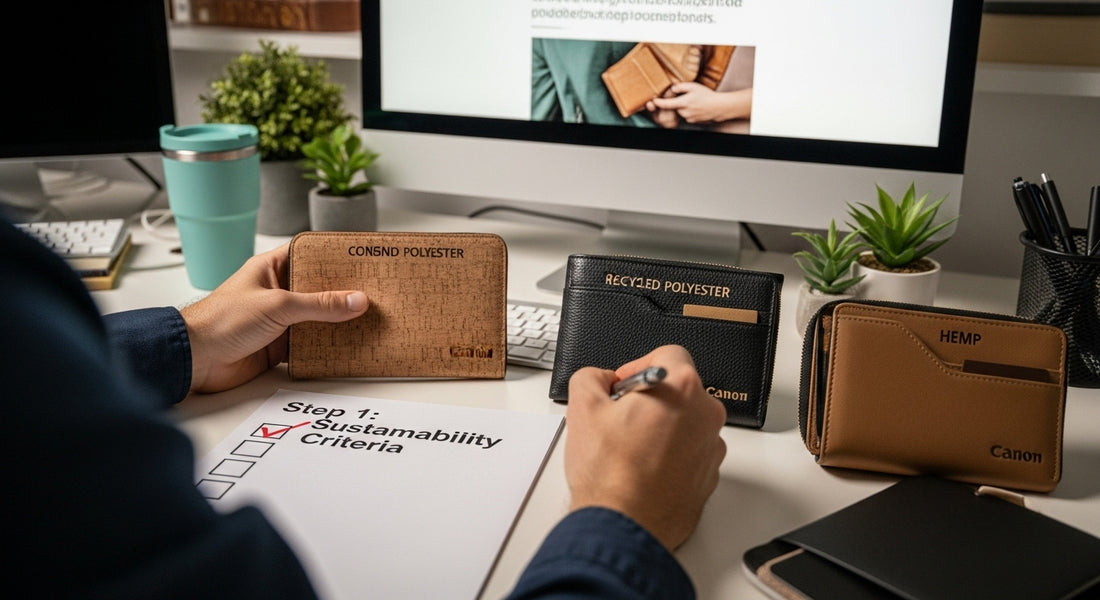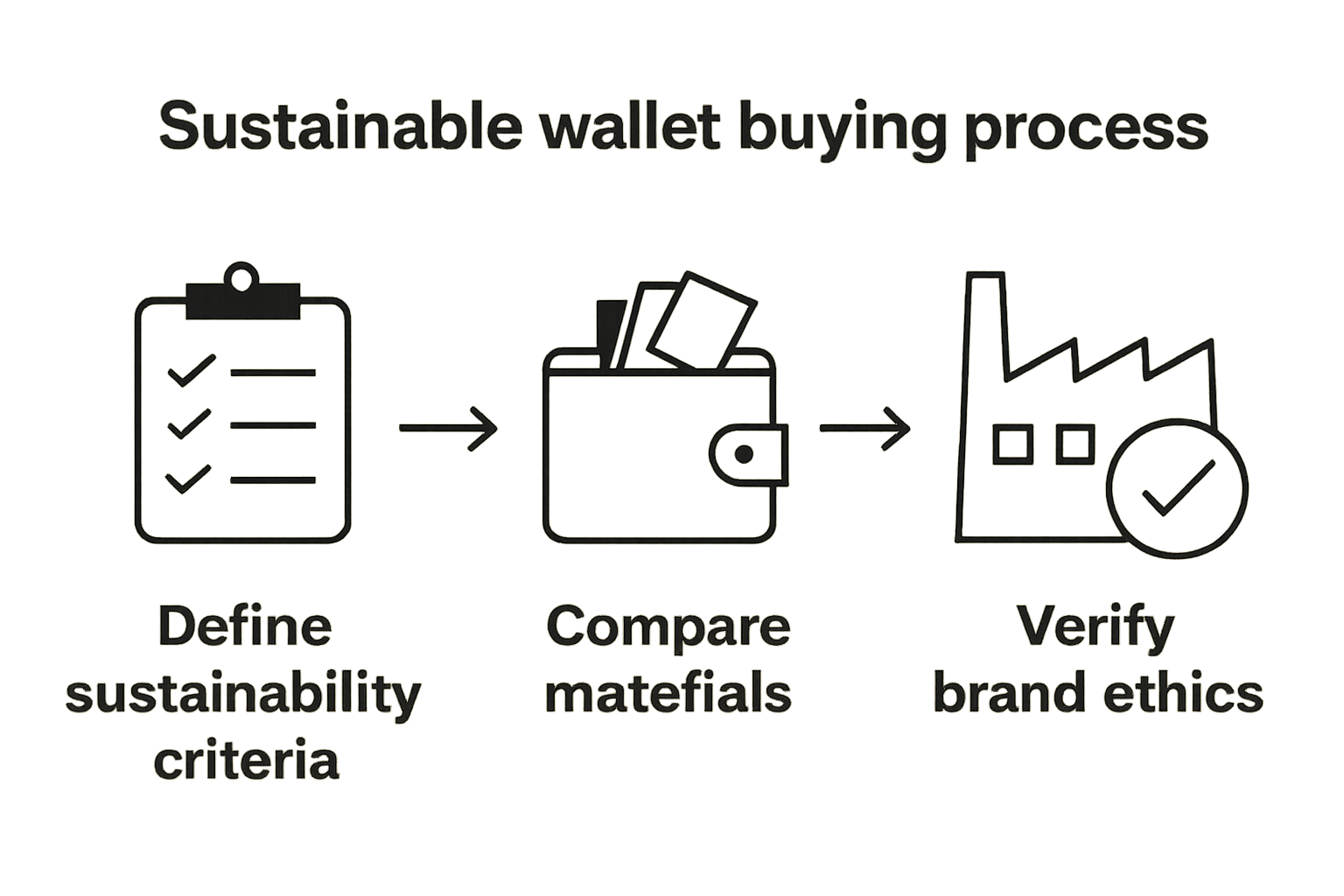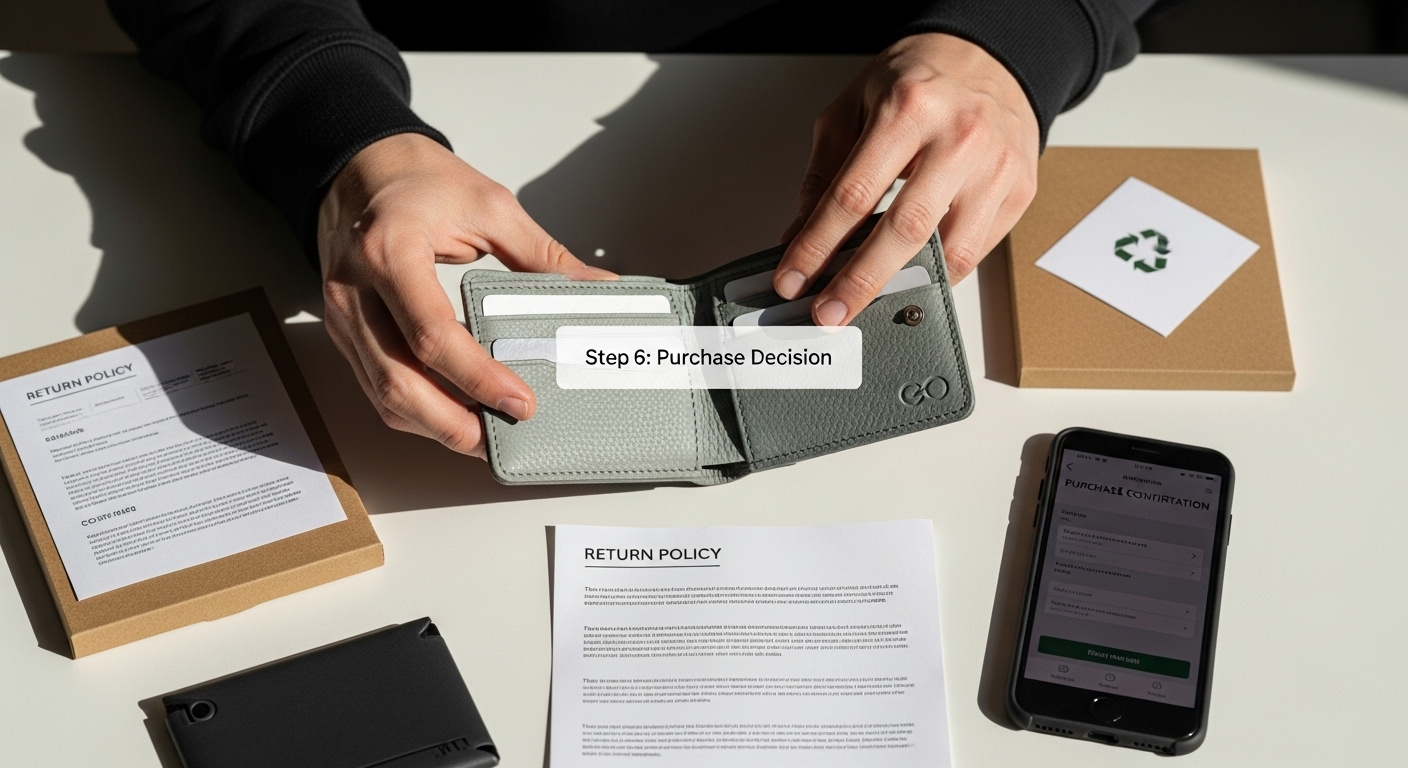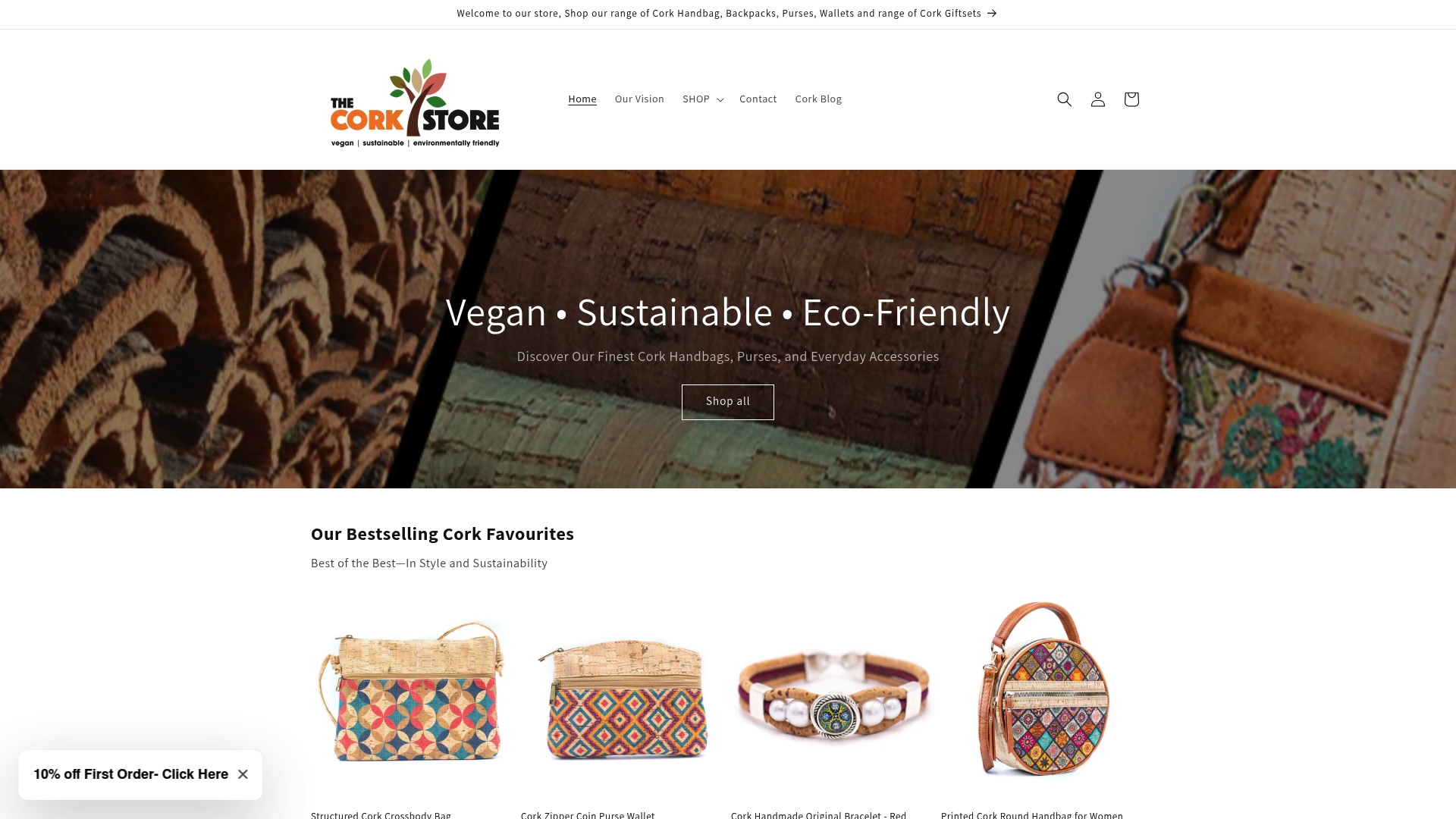
How to Choose Sustainable Wallets: A Complete Guide
Share
Picking a wallet might seem like a simple matter of colour and size. Yet, the truth is a single wallet can reflect dozens of environmental and ethical choices, from vegan materials to fair labour credentials. Most people grab the nearest option without realising that every pocket accessory has its own environmental footprint. Your next wallet could make a real difference, without looking any different at all.
Table of Contents
- Step 1: Identify Your Sustainability Criteria
- Step 2: Research Sustainable Materials
- Step 3: Analyse Brand Ethics And Practices
- Step 4: Compare Styles And Functionality
- Step 5: Check Reviews And Recommendations
- Step 6: Make Your Purchase Decision
Quick Summary
| Key Point | Explanation |
|---|---|
| 1. Define Your Sustainability Criteria | Start by outlining your core values related to sustainability, focusing on what is most important: materials, ethics, and environmental impact. |
| 2. Research Sustainable Materials | Investigate eco-friendly materials like cork and recycled polyester to understand their environmental benefits and durability for wallet production. |
| 3. Evaluate Brand Ethics | Assess a brand’s transparency, labour practices, and sustainability commitments to ensure your wallet aligns with ethical manufacturing values. |
| 4. Compare Wallet Functionality | Balance aesthetics with utility by evaluating storage needs, durability, and how well the wallet fits your lifestyle preferences. |
| 5. Review User Feedback | Consult reviews from other consumers to gain insights on real-world performance and sustainability claims before making your final selection. |
Step 1: Identify Your Sustainability Criteria
Choosing a sustainable wallet begins with a clear understanding of your personal sustainability priorities. This crucial first step helps you align your purchasing decisions with your ethical and environmental values, ensuring that your wallet reflects more than just a fashion statement.
Sustainability is a multifaceted concept that goes beyond simply avoiding leather. Your criteria should encompass material sourcing, manufacturing processes, labour practices, and overall environmental impact. Consider what matters most to you: Are you primarily concerned with animal welfare? Reducing carbon emissions? Supporting fair labour practices? Or minimising waste in production?
Start by conducting a personal sustainability audit. Reflect on the values that drive your purchasing decisions. Some key areas to examine include the materials used, the production methods, the company’s environmental commitments, and the product’s entire lifecycle. According to Stanford University’s Sustainable Purchasing Guide, responsible purchasing involves evaluating products holistically.
Compile a set of non-negotiable sustainability criteria that will guide your wallet selection. Your list might include factors such as:
- Vegan and cruelty-free materials
- Recycled or upcycled components
- Minimal carbon footprint during production
- Transparent supply chain
- Ethical manufacturing practices
Research potential wallet materials that align with your sustainability goals. Natural alternatives like cork, recycled polyester, hemp, and innovative plant-based materials offer excellent eco-friendly options. Each material has unique sustainability characteristics, so investigate their environmental credentials thoroughly.
To verify you’ve successfully completed this step, ensure you have a clear, written set of sustainability criteria that reflects your personal values and can serve as a practical checklist when evaluating potential wallet purchases. Your criteria should be specific enough to guide your decision-making but flexible enough to adapt as sustainable technologies and practices evolve.

Step 2: Research Sustainable Materials
After establishing your sustainability criteria, the next critical step is diving deep into understanding the materials that can transform your wallet from an ordinary accessory to an environmentally responsible choice. This research phase is about understanding the ecological footprint, durability, and ethical implications of different wallet materials.
Sustainable materials represent more than just an environmental statement they are a direct investment in responsible manufacturing and reduced ecological impact. Begin your exploration by examining alternative materials that challenge traditional leather production. Cork, recycled polyester, hemp, and innovative plant-based textiles are emerging as powerful contenders in sustainable accessory design.
According to the U.S. Environmental Protection Agency’s guidelines on environmentally preferable products, sustainable materials should be evaluated across multiple dimensions: resource extraction, manufacturing processes, potential for recycling, and overall lifecycle assessment.
Consider the following characteristics when researching materials:
- Carbon footprint during production
- Water consumption required for manufacturing
- Potential for biodegradability
- Recyclability and end-of-life disposal options
- Durability and longevity
Take time to understand the nuanced environmental impacts of each material.
Below is a comparison table outlining key sustainable wallet materials discussed in the article, helping you quickly assess their eco-friendly attributes for an informed selection.
| Material | Sustainability Characteristics | Durability | Additional Notes |
|---|---|---|---|
| Cork | Renewable resource, low-impact harvesting, biodegradable | High | Lightweight, unique texture |
| Recycled Polyester | Utilises post-consumer waste, reduces landfill, recyclability varies | Moderate | Petroleum-based origins may raise issues |
| Hemp | Minimal water use, low pesticide need, biodegradable | High | Naturally antimicrobial |
| Plant-based Textiles | Derived from innovative crops (e.g., pineapple), generally biodegradable | Variable | Newer options, check certification |
For instance, while synthetic materials might seem eco-friendly, their petroleum-based origins can present significant environmental challenges. Conversely, natural materials like cork offer remarkable sustainability credentials, providing renewable resources without harming trees during harvesting.
Utilise online resources, sustainability databases, and expert blogs to gather comprehensive information. Look for third-party certifications and transparent manufacturing reports that validate environmental claims. Pay special attention to materials that offer transparency about their production processes and environmental commitments.
To successfully complete this research phase, compile a detailed comparison document that outlines the pros and cons of each sustainable material against your initial sustainability criteria. Your research should provide a clear, evidence-based foundation for making an informed wallet selection that aligns with your environmental values.
Step 3: Analyse Brand Ethics and Practices
Beyond material selection, understanding a brand’s underlying ethical framework is crucial in making a truly sustainable wallet purchase. This step moves beyond surface-level marketing claims to critically evaluate the core principles and practices that define a company’s commitment to sustainability.
Ethical brand analysis requires a comprehensive approach that examines transparency, labour practices, environmental commitments, and corporate governance. You are not just purchasing a wallet, but investing in a company’s vision and operational philosophy.
According to the Global Reporting Initiative Standards, comprehensive brand assessment involves examining multiple dimensions of corporate responsibility. Start by investigating the brand’s publicly available sustainability reports, which should provide insights into their environmental impact, social commitments, and governance structures.
Key areas to investigate include:
- Supply chain transparency
- Fair wage practices
- Carbon emission reduction strategies
- Worker safety and working conditions
- Environmental certification and independent audits
Dig deeper than marketing materials. Examine third-party certifications, independent assessments, and concrete evidence of sustainable practices. Look for brands that provide detailed information about their manufacturing processes, material sourcing, and environmental impact measurements.
Research becomes more nuanced when considering smaller or emerging sustainable brands. Some may have limited reporting capabilities but demonstrate genuine commitment through transparent communication and innovative sustainable practices. Social media platforms, company websites, and sustainability forums can offer additional insights into a brand’s authentic approach to ethical production.
To successfully complete this step, create a comparative scorecard that rates potential brands against your established sustainability criteria. Your assessment should include verifiable evidence, certification details, and a holistic view of the brand’s environmental and social commitments. This methodical approach ensures your wallet purchase reflects not just aesthetic preferences, but a genuine commitment to supporting responsible and ethical business practices.
Step 4: Compare Styles and Functionality
With your sustainability criteria and brand research completed, the next crucial step involves finding a wallet that not only meets your environmental standards but also suits your practical lifestyle needs. Style and functionality are not secondary considerations they are essential elements of a wallet you will use daily.
Approach this comparison phase as a holistic evaluation that balances aesthetic preferences with practical requirements. Your ideal sustainable wallet should seamlessly integrate environmental responsibility with personal utility. Consider how the wallet will support your daily routines, organisational habits, and personal aesthetic sensibilities.
According to research on sustainable consumer products, minimalist wallet designs are increasingly aligning with eco-conscious principles, encouraging users to carry only essential items and reduce unnecessary material consumption.
Key functionality aspects to evaluate include:
- Storage capacity for cards and cash
- Durability and expected lifespan
- Weight and portability
- Ease of access to contents
- Compatibility with your personal style
Consider your specific lifestyle requirements. Are you a minimalist seeking a slim cardholder? Do you need space for multiple currencies? Are you frequently travelling and require additional security features? Each of these considerations will influence your final selection.
Visually compare different sustainable wallet designs, paying attention to how various materials and construction techniques impact aesthetics and functionality. Cork wallets, for instance, offer unique textures and lightweight properties, while recycled fabric options might provide different visual and tactile experiences.
To successfully complete this step, create a comparative matrix that ranks potential wallets against your functional requirements and aesthetic preferences. This document should objectively score each wallet option, providing a clear framework for making your final selection. Your goal is to find a wallet that feels like a natural extension of your personal style while remaining true to your sustainability commitments.
Step 5: Check Reviews and Recommendations
Navigating the landscape of sustainable wallets requires more than personal research consumer experiences provide invaluable insights that can validate or challenge your initial impressions. Reviews and recommendations serve as a critical validation mechanism, offering real-world perspectives on durability, functionality, and actual sustainability performance.
Consumer feedback represents more than simple product ratings it is a collective intelligence that reveals nuanced details about a wallet’s real-life performance. Professional reviewers, sustainability bloggers, and everyday users can offer perspectives that marketing materials cannot capture.
According to recommendations from the National Academies Press, third-party reviews are essential in verifying sustainability claims and understanding product performance beyond manufacturer descriptions.
When examining reviews, focus on these critical aspects:
- Detailed accounts of material durability
- Long-term wear and tear experiences
- Actual sustainability performance
- Comparison with manufacturer claims
- User experiences with ethical brands
Dive deep into multiple review platforms. Professional sustainability blogs, eco-fashion websites, and consumer review platforms can provide comprehensive insights. Look beyond star ratings and read detailed narratives that describe how the wallet performs in daily use, its comfort, and its genuine environmental impact.
Seek out reviews from individuals with similar lifestyle requirements to yours. A traveller’s perspective will differ from someone seeking a minimalist urban wallet. Pay attention to reviewers who discuss the wallet’s performance over extended periods, as this indicates true sustainability and durability.
To successfully complete this step, compile a summary document that cross-references professional reviews, user experiences, and your original sustainability criteria. This comprehensive review process transforms scattered information into a robust decision-making tool, ensuring your wallet purchase is both an informed and responsible choice that aligns with your environmental values.
Step 6: Make Your Purchase Decision
The final step in selecting a sustainable wallet is transforming your meticulous research into a purposeful purchase that reflects your environmental values. This moment represents more than a transaction it is a conscious choice to support responsible manufacturing and reduce ecological impact.
Review the comprehensive research you have compiled, reconnecting with your original sustainability criteria, material assessments, brand ethics evaluation, and user reviews. Your decision should feel like a natural culmination of a thoughtful, deliberate process.
According to Weill Cornell Medicine’s Sustainable Purchasing Guide, consider the entire product lifecycle when making your final selection. This means evaluating not just the immediate purchase, but the long-term environmental implications of your choice.
Consider these final decision-making criteria:
- Complete alignment with original sustainability goals
- Proven durability and long-term functionality
- Transparent and ethical manufacturing process
- Minimal packaging and shipping environmental impact
- Potential for future recycling or responsible disposal
Prepare for your purchase by double-checking the wallet’s specifications against your compiled research. Verify shipping practices, return policies, and the brand’s commitment to sustainable delivery methods. Some environmentally conscious brands offer carbon-neutral shipping or use recycled packaging materials.
Be prepared to invest slightly more in a high-quality sustainable wallet. While the initial cost might be higher than traditional options, the long-term environmental benefits and durability often justify the investment. A well-crafted sustainable wallet can last significantly longer than conventional alternatives, reducing overall consumption and waste.
To successfully complete this step, ensure your purchase meets all your established criteria. Your wallet should not just be an accessory, but a tangible representation of your commitment to environmental responsibility. Take a moment to celebrate making an informed, ethical choice that supports sustainable practices and reflects your personal values.
Use the table below as a checklist to verify your sustainable wallet purchase is fully aligned with your researched criteria and values.
| Completion Criteria | Description |
|---|---|
| Sustainability criteria matched | Does the wallet meet all your core sustainability priorities? |
| Material provenance verified | Are the materials eco-friendly and credibly sourced? |
| Brand ethics assessed | Is the brand transparent and responsible in its practices? |
| Functionality and style fit your needs | Does it offer the storage and style you require? |
| Positive user reviews and recommendations | Have others confirmed quality and sustainability? |
| Packaging and shipping confirmed | Is the packaging minimal and shipping environmentally sound? |
| End-of-life options considered | Can the wallet be recycled or disposed of responsibly? |

Discover Sustainable Style Without Compromise
You have just learned how challenging it can be to find a wallet that truly matches your ethical and eco-friendly standards. Navigating the complexity of verifying materials, brand transparency and genuine sustainability can often leave you stuck between style and substance. If you are searching for verified vegan materials, transparent supply chains and products that honour your values, your journey does not need to end in frustration.

Experience a collection where every wallet is crafted from naturally renewable cork, vegan and cruelty-free, with authentic details on sourcing and environmental impact. Visit The Cork Store now to explore our curated range of sustainable wallets and eco-conscious accessories. Make the conscious choice, enjoy durability and style with complete peace of mind and move one step closer to living your values every day. Shop today and see how simple sustainable fashion can be.
Frequently Asked Questions
What criteria should I consider when choosing a sustainable wallet?
To choose a sustainable wallet, consider criteria such as material sourcing, manufacturing processes, animal welfare, labour practices, and overall environmental impact. It’s important to align your criteria with your personal values regarding sustainability.
What materials are considered eco-friendly for sustainable wallets?
Eco-friendly materials for sustainable wallets include cork, recycled polyester, hemp, and innovative plant-based textiles. Each material has unique sustainability characteristics that should be evaluated thoroughly for their environmental impact.
How can I evaluate a brand’s ethical practices?
Evaluate a brand’s ethical practices by examining their sustainability reports, supply chain transparency, fair wage practices, carbon emission reduction strategies, and environmental certifications. Look for verifiable evidence of their commitments to responsible manufacturing and corporate governance.
Why is it important to check reviews before purchasing a sustainable wallet?
Checking reviews is important as consumer experiences can provide insights into the wallet’s durability, functionality, and actual sustainability performance. Reviews can reveal details that marketing materials might not cover, helping validate your research and guiding your final decision.
